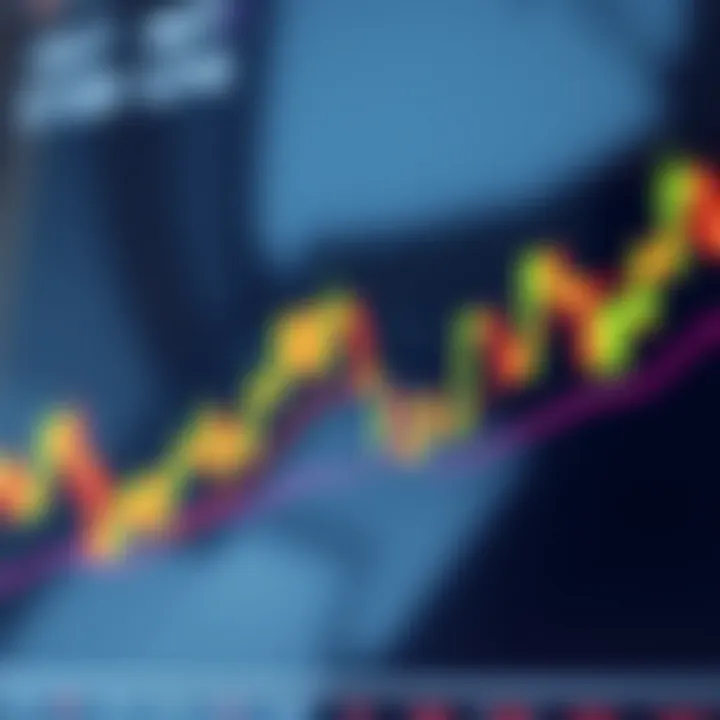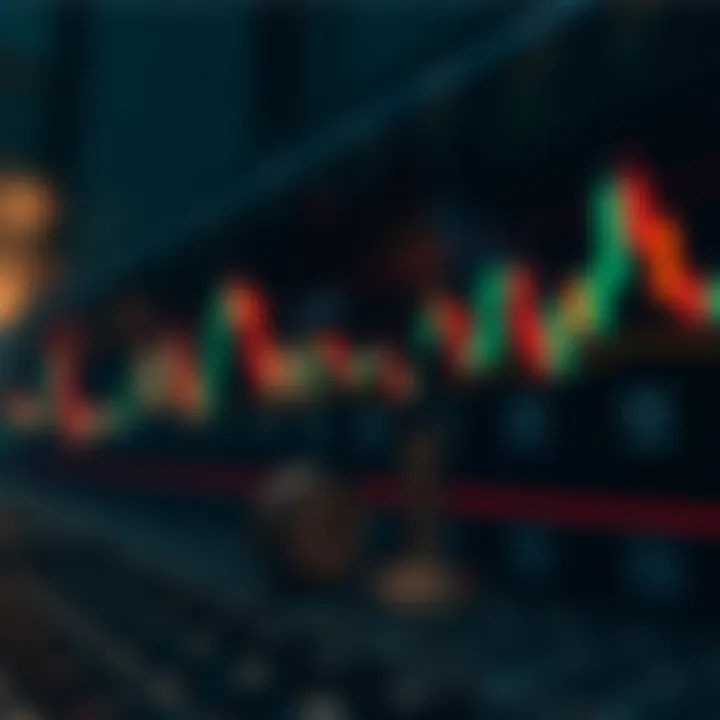Mastering Candlestick Patterns for Effective Trading


Intro
Candlestick patterns are essential tools for visual analysis in trading, offering insights into market sentiment and potential price movements. These patterns, formed by individual candlesticks on a chart, create narratives about supply and demand influences in a market. Each candlestick reflects price changes over a set period, encompassing its opening, closing, high, and low prices. For both novice investors and seasoned traders, understanding these visual cues can significantly enhance trading strategies and market analysis.
As you embark on this journey into the world of candlestick patterns, it’s vital to grasp the fundamentals and appreciate the myriad of formations available. This guide aims to dissect these patterns and provide clear insights into their practical applications, solidifying your understanding and empowering your decision-making process in various financial markets.
By integrating key concepts, recognizable formations, and strategies based on candlestick patterns, this narrative will serve as a resource that elevates your trading acumen and understanding. Let’s dive deeper into the core principles that underpin these analytical techniques.
Prologue to Candlestick Charts
Candlestick charts have evolved from a niche financial tool to a vital component of modern market analysis. For anyone venturing into securities trading or investment, understanding these charts is nothing short of essential. They are not merely colorful graphics; rather, they encapsulate price movements, investor sentiment, and market trends all in one compact visual.
Utilizing candlestick patterns can provide insights that traditional line charts might overlook. These patterns convey crucial information about market behavior, enabling traders and investors to make informed decisions. The true beauty lies in how efficiently they represent price inflation or deflation, offering essential clues to potential reversals or continuations in price movement.
The charting style, rich in history, originates from Japan over 400 years ago. It combines a unique elegance with thorough analytical prowess. For those eager to grasp the subtle intricacies of market behavior, delving into candlesticks means arming themselves with a skill that blends art and statistics.
In the coming sections of this guide, we will dissect the historical context and explore the critical significance of candlestick charts in financial analysis, enhancing our understanding of these fundamental tools in trading.
Historical Context of Candlestick Charts
Modern candlestick charts can trace their origins back to 17th century Japan. Traders in the rice market utilized these diagrams to visualize price movements and trading volumes. A merchant named Munehisa Homma is credited with developing this methodology to capture short-term market psychology. His techniques did not just reflect prices; they captured emotions, fears, and greed, emphasizing the psychological component of trading.
In sharp contrast to Western analytical methods of the time, which primarily focused on numbers, Japanese charts offered a more intuitive glance at market dynamics. Over the years, the technique was adopted internationally and recognized for its effectiveness in revealing market sentiment.
The journey from ancient Japan to the global finance stage underscores the testament to candlestick patterns. Today, they remain widely used across various financial markets, from stocks to cryptocurrencies, symbolizing not just the price history but also the intricate story of market participants’ decisions over time.
Importance in Financial Analysis
Candlestick charts serve a fundamental role in financial analysis for several reasons:
- Visual Representation: They present detailed information on price movements in a digestible format.
- Market Psychology: Each candlestick illustrates the battle between buyers and sellers, making it easier to interpret shifts in sentiment.
- Pattern Recognition: Traders can identify key patterns that signal market trends or reversal points. Recognition of these formations can lead to profitable trading opportunities.
Moreover, incorporating candlestick patterns can form the backbone of a trading strategy. Many professional traders emphasize the necessity of understanding these patterns, advocating for their integration with other technical analysis tools, such as moving averages and oscillators, to create a robust trading system.
"Candlestick patterns are like reading the tea leaves of the financial world; they tell you what might just happen next."
In summary, diving into candlestick charts opens the door to a deeper understanding of market movements. Whether one is a novice trader or a seasoned investor, these elements foster a comprehensive and nuanced grasp of market behavior, proving essential in today’s trading landscape.
Understanding Candlestick Structure
The structure of candlesticks holds a critical place in the candlestick analysis toolkit. Understanding the structure is not merely about recognizing shapes, but rather it describes the market's narrative, how buyers and sellers have acted throughout a given time period. The components that make up a candlestick—the body, upper shadow, and lower shadow—come together to convey essential information about market sentiment, potential reversals, and continuations. By dissecting these components, investors can pinpoint entry and exit points with a higher degree of precision, bolstering their overall trading strategies.
Components of a Candlestick
Body
The body of a candlestick represents the range between the opening and closing prices within a specific time frame. It’s often the most visually striking part of the candlestick and plays a defining role in conveying market activities. A long body generally indicates strong buying or selling pressure, while a short body signifies indecision among traders about the market's direction.
The key characteristic of the body is its ability to tell a story at a glance. Is it long? Is it short? Each measurement lays the groundwork for traders to glean insight into market momentum. A long body that leans green often indicates bullish sentiment, while a long red body may show bearish momentum.
However, while beneficial, the body does come with its unique features. It can, at times, paint a misleading picture if viewed in isolation. Thus, it’s essential to consider context and combine it with other indicators for a fuller market picture.


Upper Shadow
The upper shadow of a candlestick extends from the body to the highest price reached during the timeframe. It essentially represents the buying activity that pushed prices up, only to have them ultimately retreat before settling at a lower closing price. This characteristic of the upper shadow signals potential reversal points, as it indicates that buyers attempted to take control but were met with resistance.
In the context of trading analysis, the upper shadow can be a warning sign. If the upper shadow is long compared to the body, it might suggest that buyers were unable to maintain their momentum, hinting at possible downturns. Recognizing the length and position of the upper shadow helps traders gauge levels of market hesitation and shifting momentum.
Lower Shadow
Conversely, the lower shadow represents the area between the lowest price and the body's edge. It illustrates how far the price dipped before recovering, which reveals the strength of buying support within that time frame. A long lower shadow indicates that sellers tried to push down the price but were ultimately outmatched by buyers who pushed it back up.
Understanding the characteristics of the lower shadow is pivotal. A long lower shadow often suggests bullish momentum following a significant dip, serving as a potential signal to traders looking for entry points. However, just like with the upper shadow, relying solely on this feature without considering the broader market context can lead to misguided decisions.
Color Significance
The body of the candlestick can be colored either green (or white) for a bullish move, where the close is higher than the open, and red (or black) for a bearish move, where the close is lower than the open. This color-coding plays a vital role in candlestick analysis, immediately informing traders of the market trend at a glance. The use of color not only enhances visual comprehension but also introduces an emotional element into trading. For instance, if multiple red candlesticks appear, it can create a bearish sentiment that may discourage buyers. Conversely, a series of green candles can create investor confidence. Therefore, paying attention to color trends alongside the overall structure greatly aids in market analysis.
Understanding the components of a candlestick and their meanings empowers traders to make informed decisions.
In sum, grasping the structure of candlesticks goes beyond surface-level observation. When investors familiarize themselves with each element—the body, upper shadow, and lower shadow—they build a solid foundation for interpreting market sentiment and future price movements. This understanding can help investors take calculated risks, allowing for more informed trading strategies.
Key Candlestick Patterns
Understanding candlestick patterns is paramount in decoding market movements. These patterns act as barometers, reflecting psychological and emotional responses of traders and investors, thus offering a unique glimpse into the market’s pulse. When one grasps the nuances of these key formations, they can lay the groundwork for effective trading strategies that anticipate market behaviors. The significance of these patterns doesn't just lie in their exemplary visual representation; they tell stories of potential reversals, continuations, and, at times, indecision. A good grasp of this knowledge can position a trader ahead of the curve, enhancing strategy formulation.
Bullish Patterns
Bullish patterns indicate potential upward trends and suggest that buyers are gaining control. Recognizing these formations can provide traders the confidence to enter positions at optimal times.
Hammer
The Hammer pattern is a standout among bullish indicators. This formation often appears after a downtrend, symbolizing a potential reversal. Characterized by a small body at the top of the price range and a long lower shadow, it reflects a scenario where buyers push the price up after facing selling pressure. Its unique appeal lies in its simplicity. Traders often see this pattern as a beacon of hope, suggesting that the bulls are preparing to take charge. However, while the Hammer can be a strong indicator, it is essential to consider its context. Without confirmation from subsequent price action, it can sometimes lead to false signals, illuminating the need for careful analysis.
Engulfing Pattern
The Engulfing Pattern is another noteworthy bullish signal. Composed of two candles, it unfolds when a smaller bearish candle is followed by a larger bullish one. This formation indicates a significant shift in momentum where buyers overpower sellers. The key characteristic here is the size of the candles; a larger body signifies strength and conviction in the bullish move, making it a popular choice in bullish strategies. However, like with any candlestick pattern, one must confirm this with other market indicators to avoid pitfalls associated with false breakouts.
Morning Star
The Morning Star is a classic three-candle pattern symbolizing a potential trend reversal from bearish to bullish. It consists of a long bearish candle, followed by a small-bodied candle—which can be a Doji or Spinning Top— and finally, a long bullish candle. Its unique feature highlights the shift from selling to buying pressure and represents a critical pivot point in the market. Traders often find the Morning Star appealing because it provides a clear signal on a possible upward momentum; nonetheless, caution is advised, as market context plays a vital role in validation.
Bearish Patterns
Unlike bullish patterns, bearish formations signal potential downward trends, suggesting sellers gaining dominance. Recognizing these can help traders identify exit points or short-selling opportunities.
Shooting Star
The Shooting Star is a bearish reversal pattern characterized by a small body at the bottom of the trading range and a long upper shadow. This pattern usually appears at the top of an uptrend and can indicate that buyers have tried to push prices higher, but ultimately, sellers were able to take over. Its key characteristic is the length of the upper shadow, which signals rejection of higher prices. Traders often view the Shooting Star as a crucial warning sign, but one must consider the volume and subsequent price action for confirmation to avoid traps set by false signals.
Dark Cloud Cover
The Dark Cloud Cover pattern is a reliable bearish signal consisting of two candles: a bullish candle followed by a bearish candle that opens above the high of the previous day but closes below the midpoint of the bullish candle. This formation suggests that after an uptrend, sellers have begun to take control, highlighting a more pessimistic market sentiment. Its distinct feature lies in the immediate bearish candle that covers a significant part of the prior rally, giving clear indication of a shift in momentum. It's a popular formation among traders, but again, confirmation from other indicators can help in validating its effectiveness.
Evening Star


The Evening Star is akin to the Morning Star but signals a bearish reversal. This three-candle pattern starts with a long bullish candle, followed by a small-bodied candle, and then closes with a long bearish candle. The Evening Star is crucial as it illustrates the transition from buying strength to selling pressure, indicating that the market might be due for a decline. Its compelling visual and logical structure makes it a favored choice among market participants. Nonetheless, the importance of volume in confirming this pattern should not be overlooked.
Indecision Patterns
Indecision patterns highlight moments where market sentiment is uncertain, often complicating trading decisions. Recognizing these signals can illustrate potential points of market volatility and indecision.
Doji
The Doji signifies a moment of indecision in the market, characterized by a candle with nearly equal opening and closing prices. This formation indicates a balance between buyers and sellers, creating ambiguity. Traders appreciate the Doji for its simplicity and its capacity to signal potential reversals or continuations. While it can provide valuable insight into market psychology, relying solely on a Doji without subsequent price patterns can lead to misinterpretations, stressing the importance of comprehensive market analysis.
Spinning Top
The Spinning Top is another pattern that reflects a lack of consensus in the market. This formation has a small body with long upper and lower shadows, illustrating that neither buyers nor sellers could dominate during the trading session. The key characteristic of a Spinning Top is its neutrality, often appearing after significant movements, hinting at potential reversals or continuations. Though it can provide valuable insight, it's crucial for traders to look for confirming signals, as relying solely on this pattern might lead to false conclusions.
Combining Candlestick Patterns with Other Indicators
When it comes to trading, one plus one can equal more than two. Combining candlestick patterns with other indicators can amplify your trading insights. Candlestick patterns tell a story about market sentiment, but when paired with technical indicators, they paint a more complete picture. Let’s dig a bit deeper into why this combination is crucial for anyone looking to increase their trading effectiveness.
The Importance of Combination
There are several reasons why blending candlestick patterns with indicators can enhance your trading strategy:
- Improved Accuracy: Confirming signals from candlestick patterns with indicators like moving averages or RSI can help you make better-informed trading decisions.
- Better Context: Indicators provide a broader market context. They explain whether the market is bullish, bearish, or in a state of indecision.
- Stronger Signals: Indicators can reduce the noise and improve the reliability of signals from candlestick patterns, fortifying your trading positions.
To sum it up, trading is not just about chasing patterns. It is about understanding the why and how behind every pattern you see. Using candlestick patterns in conjunction with other indicators equips traders with a toolbox to navigate market turbulence.
Moving Averages
Moving averages serve as a powerful tool in trading. They smooth out price data, allowing traders to identify trends more easily. Here’s how they complement candlestick patterns:
- Trend Identification: Moving averages can help determine the general direction of the market. For example, if the price is above the moving average, it suggests an upward trend, while prices below indicate a downward trend.
- Signal Confirmation: A bullish engulfing pattern at the same time the price crosses above a moving average can make for a convincing entry point. The same goes for bearish patterns.
Moving averages can be of different types, like the simple moving average (SMA) or exponential moving average (EMA). Generally, traders prefer the EMA for its responsiveness to recent price changes.
Relative Strength Index (RSI)
The RSI is a popular momentum oscillator that helps traders identify overbought or oversold conditions. Here’s how it pairs with candlestick patterns:
- Divergence Recognition: If you see a candlestick pattern signaling a bullish trend but the RSI indicates overbought conditions, it’s a red flag. Conversely, a bearish candlestick pattern paired with a low RSI could signal strength in the downtrend.
- Timing Entries and Exits: The RSI can help determine the right moment to enter or exit a position. For example, if you’re eyeing a morning star pattern that suggests a bullish reversal, waiting for the RSI to also show an upward trend could offer an opportune moment to buy.
Remember: Using indicators like moving averages and RSI alongside candlestick patterns isn't just about confirming a trade but enhancing your overall strategy.
By combining these elements effectively, traders can significantly improve their decision-making process and minimize risks. For anyone serious about engaging in financial markets, understanding how to interpret and utilize these combinations is not optional; it’s essential.
Practical Applications of Candlestick Learning
Candlestick patterns are not just decorative charts; they serve as critical tools for traders aiming to make sound financial decisions. Understanding these patterns can lead to tangible benefits — insights that help in deciphering market trends and uncovering potential opportunities. In this section, we will delve into the various ways candlestick learning can be practically applied to enhance one's trading strategies and risk management techniques, ensuring that traders remain informed and strategic in their approach.
Creating a Trading Strategy
To successfully navigate the financial markets, a robust trading strategy is essential. The foundation of such a strategy can benefit significantly from the integration of candlestick patterns. Here’s how:
- Identifying Entry and Exit Points: Candlestick formations provide clear signals that indicate optimal times to enter or exit trades. For instance, when one observes a bullish engulfing pattern, it might be wise to consider entering a long position.
- Setting Targets: Patterns can also assist in setting profit targets. For example, after recognizing a hammer pattern, a trader might decide to set take-profit orders near previous resistance levels. This proactive approach enhances the probability of capitalizing on favorable market movements.
- Adapting to Market Sentiment: Each candlestick tells a story about market sentiment. A series of bullish candles could indicate a strong uptrend, while a cluster of bearish candles suggests a downtrend. Adapting one's strategy based on these shifts can be a game changer.


In crafting a trading strategy, one must not overlook the importance of backtesting. By evaluating how chosen candlestick patterns performed in historical market conditions, traders can refine their approach and boost their confidence.
“The best way to predict the future is to create it.” — Peter Drucker
Risk Management Techniques
While the allure of potential gains in trading is palpable, it’s equally crucial to adopt effective risk management techniques. Candlestick patterns can play a pivotal role in this regard as well:
- Setting Stop-Loss Orders: Once a trader identifies a bullish reversal pattern like a morning star, it's prudent to set a stop-loss just below the pattern’s low. This practice limits potential losses if the market doesn’t react as expected.
- Position Sizing: Understanding the risk associated with particular candlestick patterns can inform how much capital to allocate to a given trade. For instance, if a trader feels uncertain about the confirmation of a signal, they might opt for a smaller position size to mitigate risk.
- Diversifying Across Patterns: Not every pattern will yield success. Diversifying across various candlestick formations can spread out risk. For example, combining strategies based on both bullish and bearish patterns can create a balanced approach to trading.
Incorporating these risk management techniques ensures that traders operate within their risk tolerance levels, ultimately fostering a disciplined and sustainable trading practice.
The practical applications of candlestick learning extend far beyond theoretical knowledge. By employing these methods into trading strategies and risk management, traders can enhance their market approach, making it not only more effective but also more aligned with sound financial principles.
Common Mistakes in Candlestick Trading
When diving into the world of candlestick trading, one must tread carefully. The ability to read candlestick patterns can open doors to understanding market movements, yet there are pitfalls that traders often find themselves in. It's crucial to shine a light on these common mistakes to refine trading strategies and avoid unnecessary financial losses.
Traders, especially those new to the field, can easily fall prey to misunderstandings and deceptive simplicity of candlestick patterns. Recognizing and correcting these mistakes can bolster confidence and contribute to more successful trading outcomes.
Overreliance on Candlestick Patterns
One of the most pervasive errors among traders is an overreliance on candlestick patterns. While these patterns are designed to indicate potential price movements, assuming that they are foolproof can lead to mistakes. Many novice traders may think that spotting a hammer or engulfing pattern guarantees a favorable outcome. However, these patterns are just that—patterns. They are best used as indicators rather than certainties.
It's vital to remember that no single pattern gives the complete picture. For example, a bullish engulfing pattern that occurs during a downtrend may suggest a reversal, but without additional confirmation through volume or other indicators, acting on it alone can be like flying blind. Here are some considerations to keep in mind to safeguard against an overreliance on candlestick patterns:
- Combine Multiple Analysis Tools: Use candlestick formations in conjunction with other analytic tools like trend lines or technical indicators—this layered analysis can offer a more comprehensive view.
- Check Volume: Ascertain that any pattern observed is supported by trading volume. A pattern appearing with weak volume might signal mere noise rather than meaningful movement.
- Understand Market Sentiment: Keep tabs on broader market conditions. If the overall trend is bearish, a bullish pattern may just be a temporary blip rather than a suitable buy signal.
"In trading, the ‘what’ is important, but the ‘why’ can save your account."
Ignoring Market Context
Another mistake that can plague traders is ignoring the broader market context when assessing candlestick patterns. Just like a tree can’t be understood without the forest, a candlestick pattern cannot be interpreted in isolation. Trading decisions made without acknowledging the context of economic indicators, market news, or geopolitical events can lead to misjudgments.
For instance, if a trader spots a shooting star pattern but overlooks significant market news suggesting economic downturn, it may lead to unnecessary losses. Here are some key points to consider to avoid this pitfall:
- Stay Updated on News: Economic calendars and financial news sources can provide valuable insights that may influence market behavior. Events like earnings reports or policy changes can sway price movements significantly.
- Analyze Overall Market Trends: Review indices and related markets. A bullish pattern in a declining market may prove misleading if there is a dominant bearish sentiment in play.
- Factor in Broader Economic Indicators: Understand metrics like interest rates, unemployment, and inflation. These can all play a substantial role in market reactions and price movements.
By weaving in context with candlestick analysis, traders can ground their decisions in a more balanced and informed perspective. Candlestick patterns are merely one part of the puzzle; it’s the understanding of the larger market picture that can turn signs into trades with greater efficacy.
Closure
In the final analysis, understanding candlestick patterns stands as a cornerstone in the toolkit of any trader or investor. These patterns serve not only as visual cues of market sentiment but also as pivotal indicators for strategic decision-making. Their historical roots and global adoption illustrate their significance in the dynamic world of financial trading. The mastery of candlestick charts can lead to heightened awareness of market trends and potential reversals, which is invaluable in today’s volatile environment.
Reinforcing Key Takeaways
- Trends and Reversals: Candlestick patterns help identify market trends and potential reversals. By observing formations like the Hammer or Shooting Star, one can gauge the prevailing sentiment.
- Integration with Other Tools: The true strength of candlestick analysis surfaces when combined with other indicators, such as Moving Averages or the Relative Strength Index. This multi-faceted approach enables traders to make informed choices, minimizing risk and enhancing profitability.
- Practical Application: Implementing this knowledge into daily trading practices can refine decision-making processes. Creating a well-structured trading strategy that incorporates candlestick learnings can yield better results over time.
“Knowledge is power, and in the world of trading, empowering yourself through informed decisions can lead to significant financial benefits.”
Encouraging Ongoing Learning
The journey into the realm of candlestick patterns doesn't end here; it's merely just the beginning. Financial markets are always shifting, and staying abreast of trends, new patterns, and evolving strategies is vital. Here are some steps to foster ongoing learning:
- Follow Educational Resources: Regularly visit trading education platforms, webinars, or forums like Reddit or professional trading courses to expand your understanding.
- Practice and Observe: Utilize simulation tools or demo trading accounts to practice recognizing patterns without financial risk. Observing how patterns play out in real-time data deepens comprehension.
- Engage with Community: Joining trading groups or online forums can provide insights and peer feedback, enhancing your learning and confidence in using candlestick patterns.
By committing to continuous education and engagement with the financial community, traders not only refine their skills but also adapt to changes in market behavior, ensuring ongoing success in their trading endeavors.
For additional resources, check out Investopedia, Wikipedia, or visit educational trading platforms that offer further insights into the topic.







